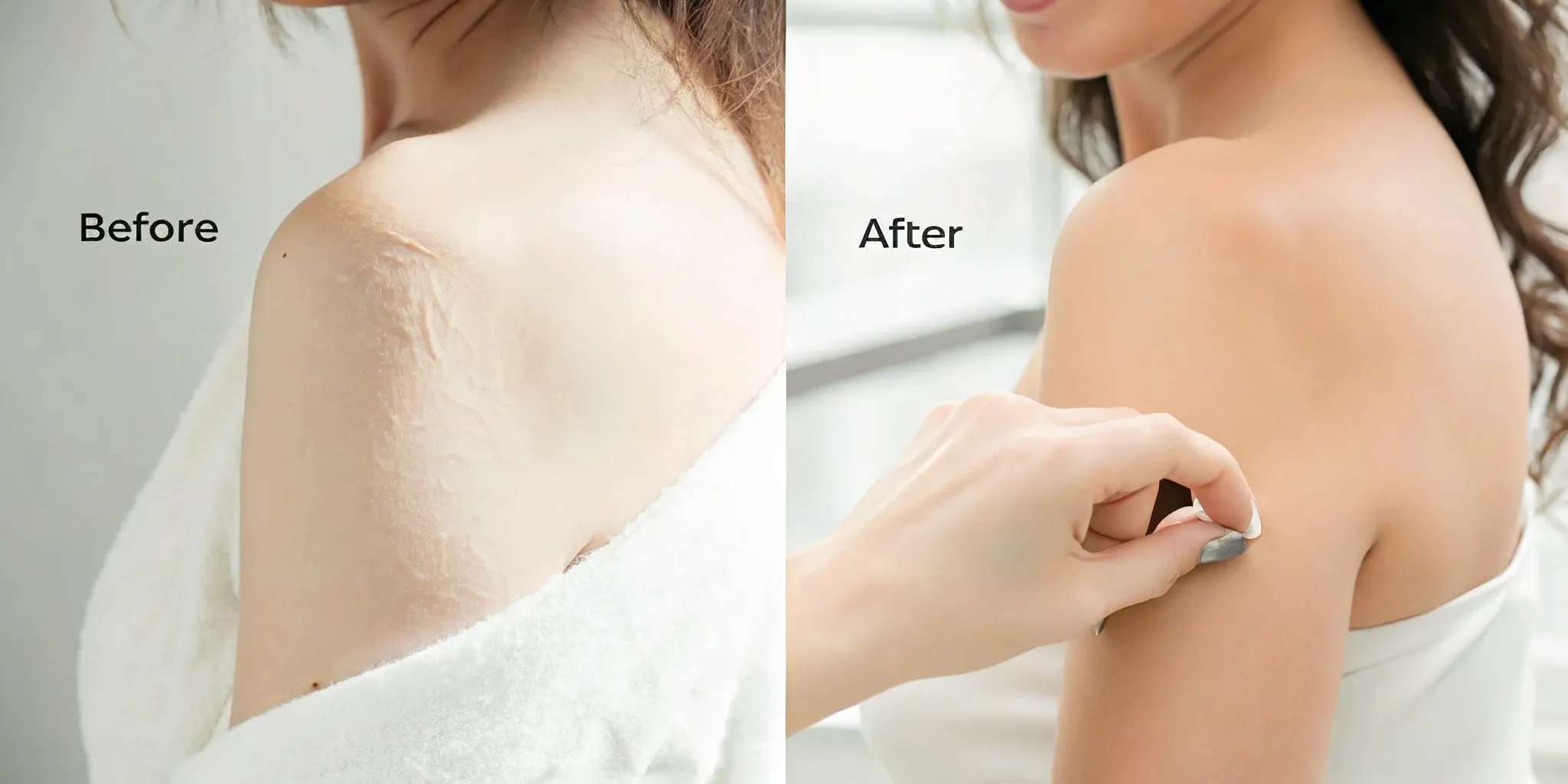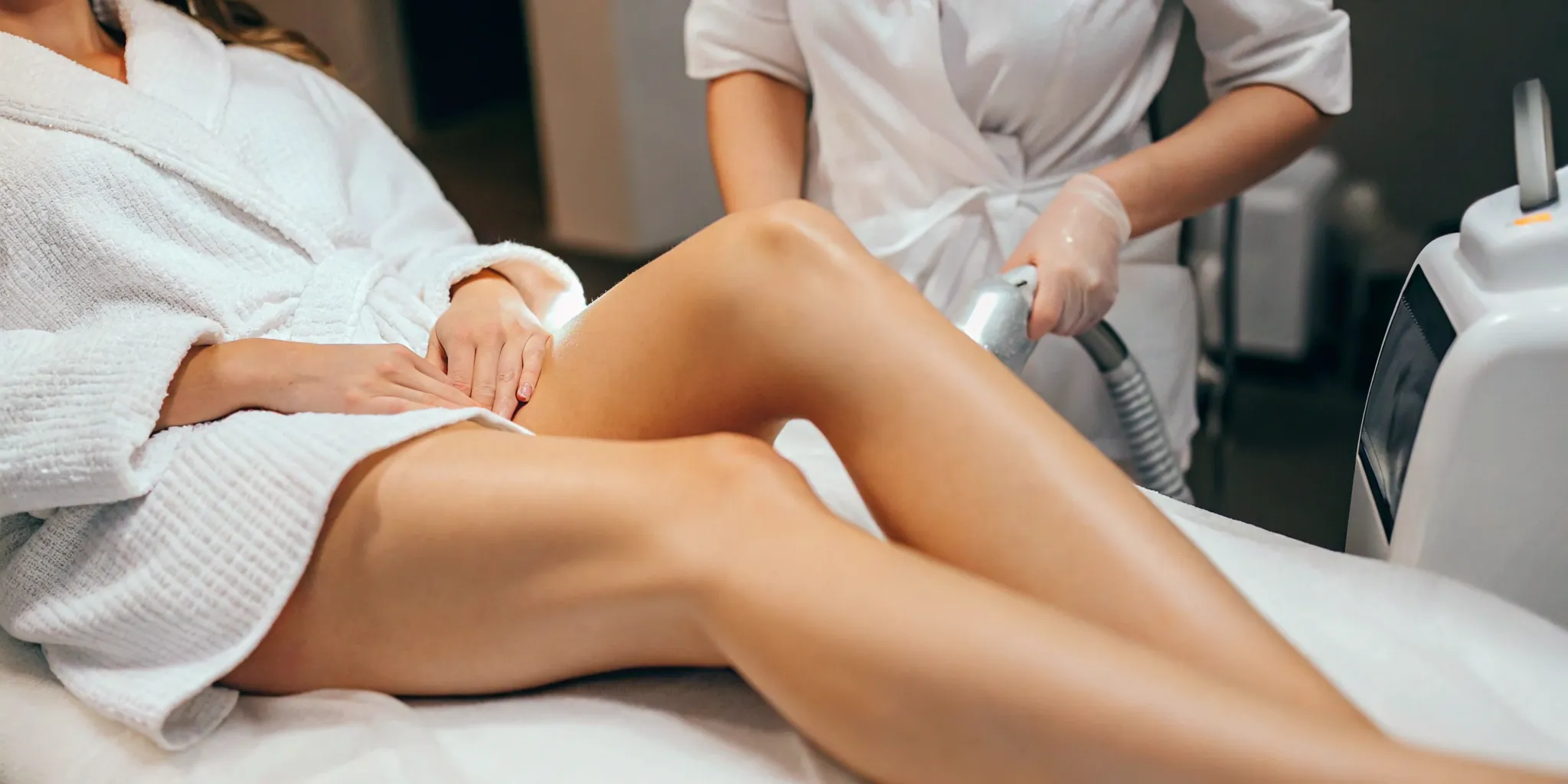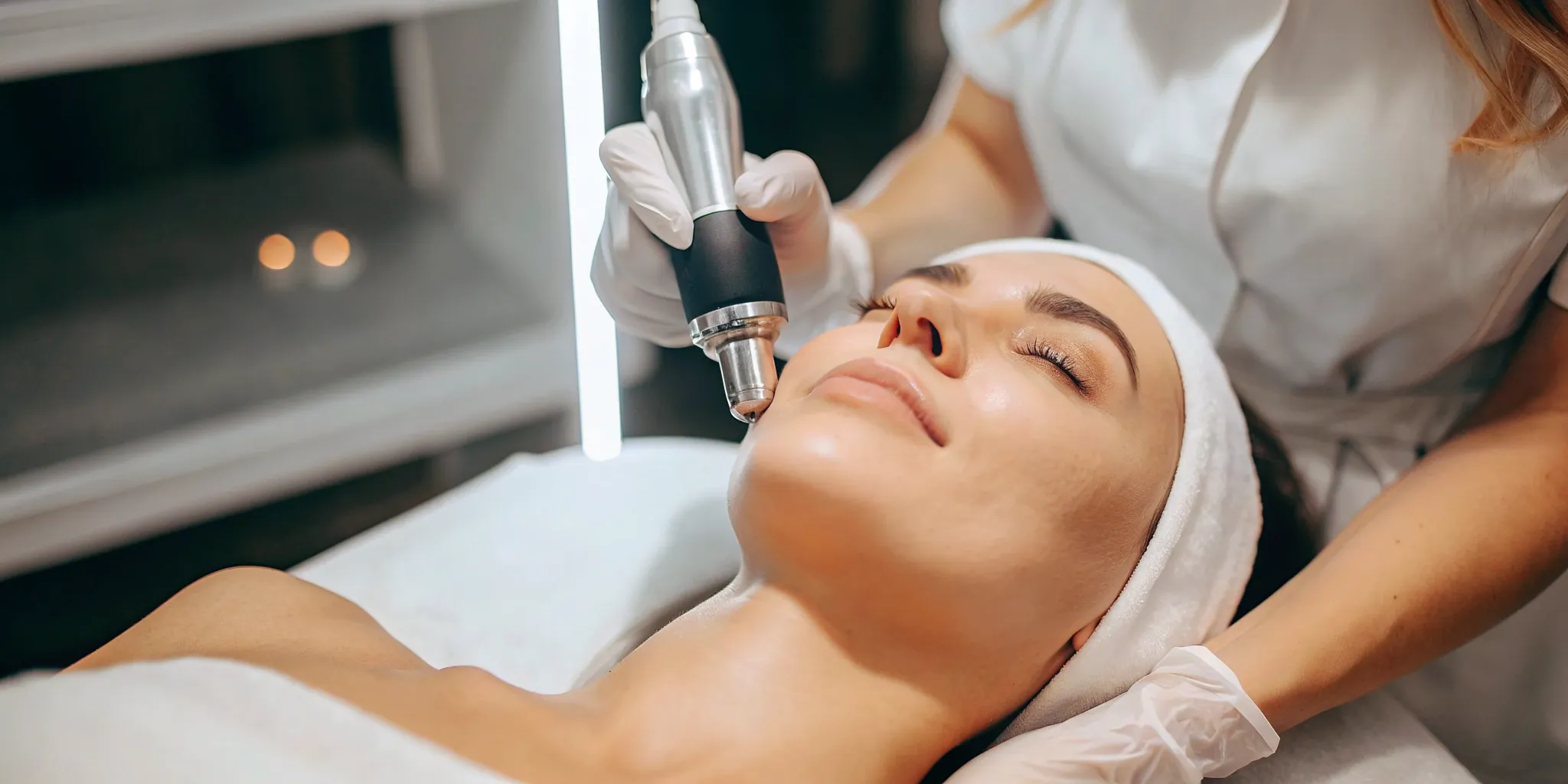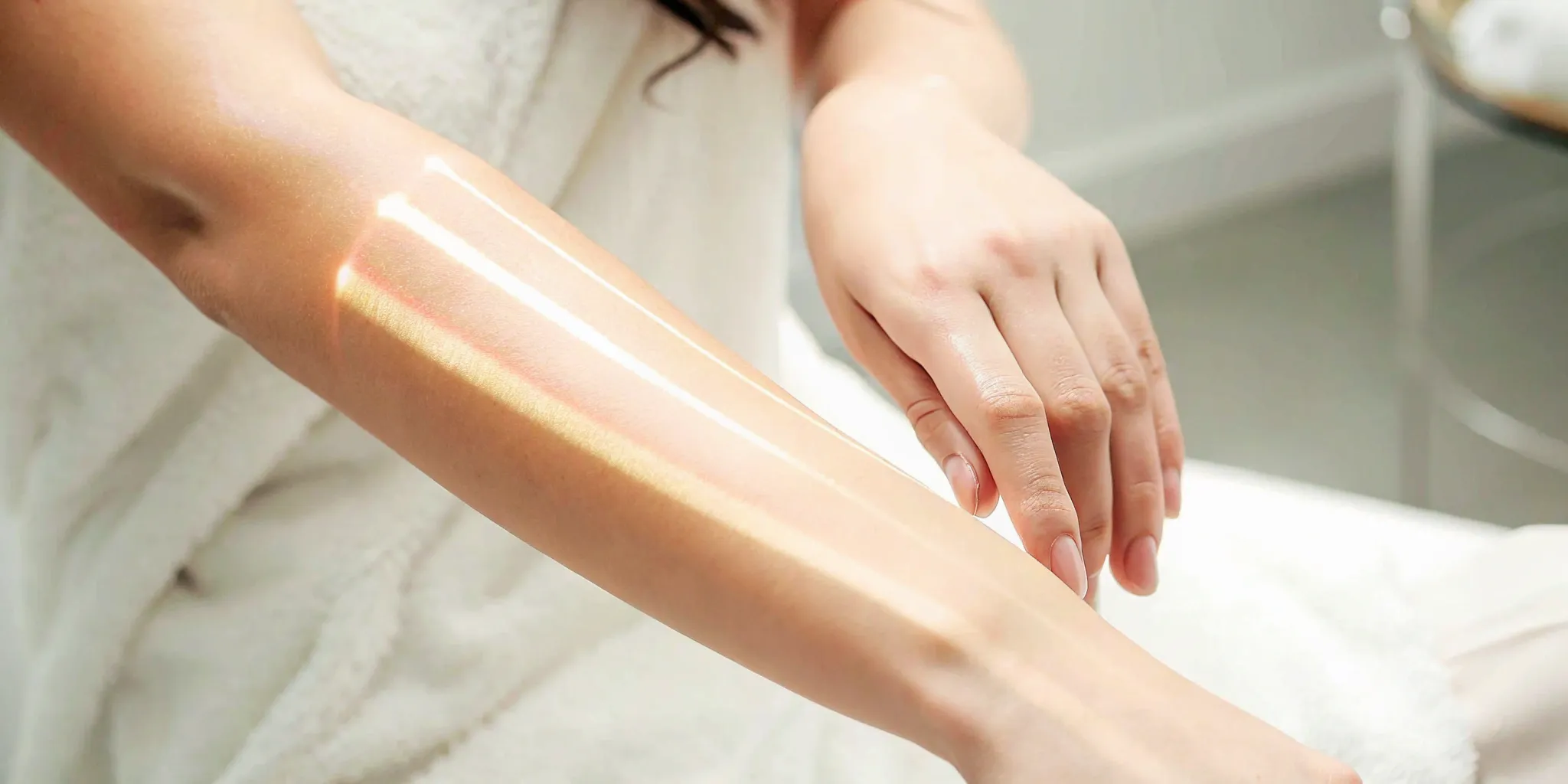The idea of using a laser to erase ink from your skin can sound like something out of a sci-fi movie. But the science behind it is actually quite straightforward. Think of the ink particles in your tattoo as large rocks that are too big for your body to clear away. The laser sends ultra-fast pulses of light that act like a hammer, shattering those rocks into tiny, sand-like fragments. From there, your body’s own immune system does the rest, naturally flushing the particles away. This guide demystifies the entire laser tattoo removal process, explaining the technology, what makes it safe, and how it partners with your body to achieve clear skin.
Key Takeaways
- Understand the Process is a Partnership with Your Body: Laser tattoo removal isn’t a one-and-done magic trick. The laser shatters the ink, but your immune system does the heavy lifting of clearing it away. This requires multiple sessions spaced weeks apart, and your results will depend on your tattoo’s age, colors, and your personal health.
- Do Your Homework When Choosing a Provider: Your safety and results depend entirely on who you choose. Prioritize medically supervised clinics with certified technicians and modern laser technology. Use your consultation to ask direct questions about their experience, the equipment they use, and what you can realistically expect.
- Commit to Aftercare for the Best Results: What you do between sessions is just as important as the treatment itself. Diligently follow your provider’s instructions, especially by keeping the area clean and protected from the sun. Supporting your body with good hydration and healthy habits will also help your immune system clear the ink more effectively.
What Is Laser Tattoo Removal?
If you’re rethinking some ink, you’ve probably heard about laser tattoo removal. It’s the most effective and trusted method for clearing a tattoo you no longer love. At its core, laser tattoo removal is a medical procedure that uses highly concentrated light beams to break down the ink particles embedded in your skin. Over a series of treatments, the laser works to shatter the ink into tiny fragments, which your body’s natural immune system then flushes away. This gradual process causes the tattoo to fade and eventually disappear.
It’s not a magic eraser that works in one session, but rather a partnership between advanced technology and your body’s own ability to heal. The process is tailored to your specific tattoo—considering its size, colors, and age—and your skin type. When performed by a trained professional at a reputable clinic, it’s a safe way to achieve a clean slate. At Ultimate Image MedSpa, we use state-of-the-art lasers to provide safe and effective tattoo removal treatments, ensuring you get the best possible results on your journey to clear skin.
How Does the Laser Break Down Ink?
Think of your tattoo ink as large rocks sitting deep within your skin. They’re too big for your body to remove on its own. The laser acts like a high-powered hammer, sending incredibly fast pulses of light energy into the skin. This energy is specifically absorbed by the tattoo ink, not the surrounding tissue. The intense energy heats the ink particles and shatters them into tiny, sand-like pieces. Once the ink is broken down into these much smaller fragments, your body’s immune system can finally go to work. It recognizes these particles as foreign objects and clears them away naturally over time, causing the tattoo to fade with each session.
Exploring Different Laser Technologies
Not all lasers are created equal, and the technology has come a long way. Early lasers were effective but could be harsh on the skin. Today, we use advanced systems like picosecond lasers, which deliver energy in ultra-short pulses (trillionths of a second). This speed creates a photo-acoustic effect that shatters ink more efficiently with less heat, which means more effective removal and less risk to the surrounding skin. For example, the PicoSure laser is exceptionally good at breaking down stubborn blue and green inks, which were once considered almost impossible to remove. Using the right laser technology is key to getting great results, especially for colorful and complex tattoos.
Matching Lasers to Ink Colors
The color of your tattoo ink plays a huge role in how the removal process works. Different ink colors absorb different wavelengths of light, so your technician will match the laser to your specific tattoo. Black ink is the easiest to remove because it absorbs all laser wavelengths, much like a black shirt absorbs sunlight. On the other hand, vibrant colors require more specific targeting. Reds and yellows can be treated effectively, but lighter colors like pastels, white, and fluorescent inks are often the most challenging. Green ink, in particular, can be very stubborn, but modern picosecond lasers have made its removal much more achievable than in the past.
New and Improved Laser Technology
The world of aesthetic technology is always advancing, and laser tattoo removal is no exception. Companies are constantly refining their systems to be safer, faster, and more effective on a wider range of ink colors. For instance, the PicoWay laser system recently received expanded FDA clearance, allowing it to treat a broader variety of tattoo types and pigmented lesions. These improvements are great news for anyone considering removal. They mean that tattoos that were once difficult to treat can now be faded more completely, often in fewer sessions and with greater comfort. This commitment to innovation ensures you’re getting the most advanced care available.
Debunking Common Tattoo Removal Myths
You’ve probably seen ads for tattoo removal creams and wondered if they work. The short answer is no. These creams are not regulated by the FDA and simply can’t deliver on their promises. Tattoo ink sits in the dermis, the second layer of your skin, while creams only treat the epidermis, the top layer. At best, they do nothing; at worst, they contain harsh acids or bleaching agents that can cause painful chemical burns, rashes, and permanent scarring without ever touching the ink. The only proven method for safely removing tattoo ink is with a laser administered by a trained professional. Don’t risk damaging your skin with an ineffective product.
What Happens During a Treatment Session?
Knowing what to expect can make your tattoo removal journey feel much more approachable. From your first conversation with a specialist to the aftercare you’ll follow at home, each step is designed to be clear and straightforward. Let’s walk through the entire process, so you can feel confident and prepared for your appointment.
The First Step: Your Consultation
Your journey begins with a personalized consultation. This is your opportunity to sit down with a specialist, discuss your goals, and ask any questions you have. During this meeting, the provider will examine your tattoo, taking note of its size, location, ink colors, and age. Based on this assessment and your skin type, they will create a custom treatment plan just for you. This plan will outline the estimated number of sessions you’ll need and what you can expect from the results. It’s the perfect time to get all the information you need before you schedule your first session.
The Removal Procedure, Step by Step
The actual removal process is surprisingly quick. Your specialist will use a state-of-the-art laser to send highly concentrated pulses of light energy into your skin. This energy is absorbed by the tattoo ink, shattering the large particles into tiny fragments. Think of it like breaking a large rock into small pebbles. Over the following weeks, your body’s natural immune system gets to work, clearing away these tiny ink particles. This gradual flushing process is what causes the tattoo to fade. Each session breaks down more ink, making the tattoo lighter and lighter until it’s gone.
How to Manage Discomfort
It’s completely normal to wonder if the procedure will hurt. Most people describe the sensation as similar to a rubber band snapping against the skin—uncomfortable, but manageable. To ensure you’re as comfortable as possible, your provider will typically apply a topical numbing cream to the area before the treatment begins. Many clinics also use a cooling device that blows chilled air onto the skin during the session, which helps soothe the area and minimize any discomfort. Your provider’s top priority is your safety and comfort throughout the entire laser tattoo removal process.
What Is the Recovery Like?
Immediately after the treatment, you might notice the area looks white or “frosted.” This is a normal and temporary reaction that indicates the laser is effectively targeting the ink. You can also expect some redness, mild swelling, and tenderness for a few hours to a couple of days, similar to a sunburn. These are all signs that your body is beginning the healing process. While you’ll see some fading after each appointment, remember that tattoo removal is a gradual journey. Most people see significant improvement after a series of sessions spaced several weeks apart.
Caring for Your Skin After Treatment
Proper aftercare is key to achieving the best results and ensuring your skin heals beautifully. Your provider will give you specific instructions, but some general guidelines apply. You’ll want to avoid strenuous physical activity for a day or two to prevent irritation. It’s also crucial to protect the treated area from the sun until it’s fully healed, as UV exposure can affect the healing process. Keeping the area clean and moisturized as directed will support your skin’s recovery. Following these simple steps will help you get the most out of your professional treatments.
What Determines Your Tattoo Removal Results?
Thinking about laser tattoo removal is exciting, but it’s natural to wonder what the final outcome will look like. The truth is, the process is different for everyone. Your results depend on a unique combination of factors, from the tattoo itself to your own body’s ability to heal. It’s not a simple one-size-fits-all procedure, and the journey to clear skin is highly personal.
Understanding these key elements from the start helps you set clear and realistic expectations. When you know what influences the process, you can feel more confident and prepared for each session. Let’s walk through the main factors that will shape your tattoo removal experience and determine how effectively we can fade or erase your unwanted ink.
Your Tattoo’s Age, Size, and Ink
Not all tattoos are created equal, and their specific characteristics play a huge role in the removal process. Older tattoos that have already faded a bit are often easier to remove than fresh, vibrant ones. This is because your body has already had years to naturally break down some of the ink. The size of your tattoo is another straightforward factor—larger, denser pieces will require more sessions than a small, simple design. The amount of ink used also matters; a tattoo with heavy shading and deep saturation will take more work to break down than one with delicate, fine lines. During your consultation, we’ll assess these details to create a tailored laser tattoo removal plan just for you.
How Skin Tone and Tattoo Placement Matter
Your body is your partner in the removal process, and where your tattoo is located can make a difference. Tattoos in areas with strong blood circulation, like your torso or neck, tend to fade faster. The robust blood flow helps your immune system efficiently carry away the shattered ink particles. Tattoos on your hands, feet, or ankles might take a bit longer because these areas have less circulation. Your skin tone is also a factor. Modern lasers are designed to be safe and effective for all skin types, but we may adjust the laser’s settings for darker skin to protect your natural pigment. This ensures a safe treatment but may sometimes require a few extra sessions to achieve the desired result.
The Role of Your Health and Lifestyle
The laser does the work of breaking up the ink, but your immune system is what actually removes it from your body. This means your overall health is a key player in how well the treatment works. A strong, healthy immune system can clear the ink particles more effectively. You can support this process with simple lifestyle choices. Staying hydrated, getting plenty of sleep, and eating a nutritious diet all contribute to a better outcome. On the other hand, smoking can constrict blood vessels and slow down circulation, which may hinder the removal process. Think of it as giving your body the best tools to heal and clear the ink after each session.
How to Set Realistic Expectations
It’s important to go into laser tattoo removal with a clear and realistic mindset. While complete removal is often possible, some tattoos can be incredibly stubborn. For some, success means the tattoo is completely gone. For others, it might mean fading the ink enough for a beautiful cover-up piece. The goal is always to achieve the best possible clearance, but factors like ink colors and depth can make some tattoos more challenging to erase entirely. The best way to understand what’s possible for your specific tattoo is to schedule a consultation. A professional can assess your ink and give you an honest, personalized outlook on your expected results.
Which Ink Colors Are Easiest to Remove?
The color of your tattoo ink is one of the most significant factors in the removal process. Black ink is generally the easiest to treat because it absorbs all laser wavelengths, allowing it to break down efficiently. Darker colors like deep blues and reds also tend to respond well to the laser. However, lighter and brighter colors can be more stubborn. Shades of green, yellow, and light blue are notoriously difficult to remove because they selectively absorb light and require very specific laser wavelengths to target them effectively. While our advanced laser technology can tackle a wide spectrum of colors, it’s good to know that a multi-colored tattoo will likely require more patience and sessions than a simple black one.
How Long Will It Take and What Will It Cost?
Let’s talk about the two biggest questions on everyone’s mind: how long will this take, and what’s the damage to my wallet? The truth is, there’s no single answer. Your tattoo removal journey is as unique as the ink itself. The total time and cost depend on several factors, from your tattoo’s size and color to your own body’s healing process. Think of it less like a one-time purchase and more like a personalized treatment plan.
While I can’t give you an exact number, I can walk you through all the elements that determine your timeline and final price. We’ll look at how many sessions you can expect, why patience between appointments is so important, and what goes into the cost of each treatment. Understanding these details will help you feel confident and prepared as you move forward with laser tattoo removal. We’ll also cover the different payment options available, so you can find a plan that works for you.
Estimating Your Number of Sessions
Most people need between six and 12 sessions to achieve their desired results. This is a general estimate, and your specific needs will be determined during your consultation. A small, faded, black ink tattoo might be on the lower end of that range, while a large, vibrant, and newer piece will likely require more appointments.
Each session breaks down more ink, but it’s your body that does the hard work of clearing it away. The number of sessions is designed to give your immune system enough time to process the ink particles effectively without overwhelming your skin. Your provider will create a personalized plan that gives you the best results in the safest way possible.
Why You Need to Wait Between Sessions
It can be tempting to schedule your appointments close together to speed things up, but patience is key. We typically schedule laser tattoo removal sessions at least six to eight weeks apart. This waiting period is non-negotiable, and it’s for your own benefit. It gives your skin the time it needs to heal completely from the laser treatment, which is essential for preventing irritation and potential scarring.
More importantly, this interval allows your body’s lymphatic system to do its job: flushing out the tiny ink particles that the laser shattered. Rushing this natural process won’t get you better results—in fact, it can hinder them. Sticking to the recommended schedule ensures your skin stays healthy and the removal is as effective as possible.
Breaking Down the Cost Per Session
The cost of laser tattoo removal can range from $200 to $500 per session. This price variation comes down to the specifics of your tattoo. A simple, postage-stamp-sized tattoo will naturally cost less per session than a complex, full-sleeve design. During your initial consultation, your provider will assess your tattoo and give you a precise quote per session.
This per-session pricing model allows you to pay as you go, making the overall cost more manageable. Many people find it helpful to budget for their treatments one at a time. To get a personalized quote based on your specific tattoo, the best first step is to schedule a consultation with a qualified professional.
What Influences the Final Price?
Several key factors come together to determine the total cost of removing your tattoo. The most significant is size—larger tattoos require more time and energy from the laser, which is reflected in the price. The type and color of the ink also play a major role. Some pigments, like black and dark blue, are easier to break down, while lighter colors like green, yellow, and light blue can be more stubborn.
The location of your tattoo matters, too. Tattoos on areas with good circulation, like your torso, tend to fade faster than those on your hands or feet. Finally, the ink’s density and whether it was done by a professional or an amateur can affect how many sessions you’ll need, which in turn influences the final cost.
Exploring Payment and Financing
Investing in yourself should be an exciting decision, not a stressful one. We understand that tattoo removal is a financial commitment, which is why many medspas offer flexible payment options to make the process more accessible. Instead of paying for everything upfront, you can often pay per session, which allows you to spread the cost out over the entire course of your treatment.
Some clinics also offer package deals, where you can purchase a set number of sessions at a discounted rate. This can be a great way to save money if you know you’ll need multiple treatments. Be sure to ask about all available payment and financing options during your consultation so you can choose the path that best fits your budget.
Your Guide to Safe Removal and Aftercare
A successful tattoo removal journey doesn’t end when you leave the medspa. How you care for your skin afterward is just as important as the treatment itself. Following a proper aftercare routine helps your skin heal correctly, reduces the risk of complications, and leads to the best possible results. Think of it as a partnership between you and your provider. We handle the advanced laser work, and you handle the simple, yet crucial, steps at home. Here’s a straightforward guide to preparing for your appointment and caring for your skin throughout the removal process.
How to Prepare for Your Appointment
Getting ready for your laser session is simple and can make a real difference in your results. The most important step is to protect your skin from the sun. Try to avoid direct sun exposure on the tattooed area for at least a couple of days before your appointment, as this helps minimize skin sensitivity. During your initial consultation, our specialists will assess your tattoo and create a personalized treatment plan for you. We’ll walk you through everything, including an estimate of how many sessions you might need, so you know exactly what to expect. Following these pre-treatment guidelines helps us ensure the laser can work as effectively as possible on your tattoo’s ink.
What to Do Right After Your Session
Immediately after your treatment, you’ll notice some changes to your skin, and it’s helpful to know what’s normal. The treated area might look white or “frosted” for a short time—this is a sign the laser energy was properly absorbed. It’s also common to experience some redness, mild swelling, and tenderness for a few hours or up to a couple of days. As your skin begins to heal, you might see tiny spots of blood, blisters, or light scabs form. Don’t be alarmed; this is your body’s natural healing response at work. We provide detailed aftercare instructions to help you manage these effects and keep the area clean and protected.
Caring for Your Skin Long-Term
Patience and consistent care are key to getting the clear skin you want. In the days following your treatment, it’s best to avoid strenuous physical activity that could irritate the area. It’s also absolutely crucial to keep the treated skin out of the sun until it’s completely healed to prevent complications or discoloration. For the best results, most people need a series of laser tattoo removal sessions spaced several weeks apart. This waiting period gives your body time to flush out the ink particles and your skin time to recover fully. Sticking to your aftercare routine between every session will support the healing process and help you achieve a better final outcome.
How to Handle Common Side Effects
Many people worry that tattoo removal will be painful, but it’s often described as less uncomfortable than getting the tattoo in the first place. We use advanced lasers designed to protect your skin, and we can recommend using ice packs or specific healing creams to soothe the area afterward. The most common side effects, like redness and swelling, are temporary and manageable. The best way to handle them is by carefully following all the aftercare instructions your provider gives you. This includes keeping the area clean, moisturized, and shielded from the sun. Proper care not only makes you more comfortable but also helps your skin heal beautifully.
When to Call Your Provider
While side effects are usually mild, it’s important to know when to reach out for help. If you notice excessive redness or swelling that doesn’t improve, or see any signs of infection like pus or increased pain, you should contact us immediately. Your safety is our top priority. Choosing an experienced, medically supervised facility for your treatment is the best way to minimize risks from the start. Our team is always here to answer your questions and address any concerns you have during your healing process. Never hesitate to call if something doesn’t feel right—we’re here to support you every step of the way.
Comparing Top Tattoo Removal Providers
Choosing a provider is a big decision, and it helps to know who the key players are. Different clinics have unique strengths, from their technology and pricing models to their overall approach to client care. To help you get started, here’s a look at some of the top tattoo removal providers you might consider, including what makes each one stand out.
Ultimate Image MedSpa
At Ultimate Image MedSpa, the focus is on creating a comfortable and supportive experience. We understand that the thought of discomfort can be a major hurdle, which is why we prioritize your well-being throughout the process. As we say, “we use cooling methods to keep you comfortable throughout the laser tattoo removal process.” This commitment to comfort, combined with our medically supervised treatments, ensures you’re in safe, caring hands. If you’re looking for a provider that pairs expert results with a personal touch, our team is here to guide you. We build a personalized treatment plan designed just for you.
LaserAway
LaserAway is a well-known name in the aesthetics industry with locations across the country, including Fort Worth, Texas. They are known for offering a broad range of services beyond just tattoo removal. According to their site, “LaserAway offers laser tattoo removal services in Fort Worth, Texas. They promise competitive prices, fast results, and safe, effective treatments.” This makes them a strong contender if you’re looking for a provider with a national reputation that emphasizes efficiency and value. Their wide presence can also be a plus for those who might move or travel frequently.
Removery
Removery stands out with its singular focus on tattoo removal and a unique pricing structure. They are specialists in the field, dedicating all their resources and training to removing tattoos. Their most notable feature is the “Complete Removal Package,” where you pay a single price for as many sessions as it takes to completely remove your tattoo. This can offer incredible peace of mind, especially if you have a complex or stubborn tattoo. It removes the uncertainty of per-session costs, allowing you to budget for your removal with confidence from the very beginning.
Milan Laser
Milan Laser is another major provider that specializes exclusively in laser treatments, with a heavy focus on laser hair removal and tattoo removal. As a large, national chain, they emphasize using top-of-the-line technology and having highly trained medical professionals perform all procedures. Their approach is centered on providing a consistent and professional experience at all of their locations. For clients who value the backing of a large, specialized company and want access to the latest laser advancements, Milan Laser is a solid choice to explore.
Ideal Image
Ideal Image is one of the leading aesthetic brands in North America, offering a comprehensive menu of non-invasive cosmetic procedures, including laser tattoo removal. Their main selling point is their reputation as a trusted, medically-led company with a strong emphasis on safety and standardized treatment protocols. Because they offer a wide variety of services, they can be a great option for clients who are interested in addressing multiple aesthetic goals under one roof. Their focus is on delivering reliable results using advanced, FDA-cleared technology in a professional clinic environment.
Clean Slate Laser
Clean Slate Laser operates as a more specialized, boutique-style clinic with a primary focus on tattoo removal. Providers like this often pride themselves on offering highly personalized treatment plans tailored to each client’s unique tattoo and skin type. They typically invest in state-of-the-art laser technology to handle a wide range of ink colors and complexities. If you prefer a more intimate clinic setting where you can build a close relationship with your technician and receive a deeply customized approach, a specialized provider like Clean Slate Laser could be the perfect fit.
Eraser Clinic
Eraser Clinic is another provider that specializes in tattoo removal, positioning itself as an expert in the field. Their core mission is to deliver the most effective results possible by employing advanced laser techniques and staying current with the latest industry practices. Clinics like Eraser Clinic often attract clients who are primarily focused on one thing: getting rid of their tattoo as completely and efficiently as possible. They build their reputation on their ability to tackle difficult tattoos and deliver visible progress, making them a strong option for anyone whose top priority is the final outcome.
How to Choose the Right Provider for You
Finding the right professional for your tattoo removal is the most important step in your journey. The provider you choose determines the technology used, the safety of the procedure, and the quality of your results. With so many options available, it can feel overwhelming, but focusing on a few key areas will help you find a clinic you can trust. Think of it as a partnership—you want someone who is knowledgeable, uses modern equipment, and makes you feel completely comfortable and supported from start to finish.
Your choice will directly influence how smooth the process is and how happy you are with the outcome. A great provider will offer a clean, professional environment, typically a medspa or a clinic with medical oversight, which ensures the highest standards of care. They will be transparent about everything from their team’s qualifications to the specific laser they’ll be using on your skin. While it can be tempting to shop around for the lowest price, remember that this is a medical procedure. Bargain-hunting can lead to inexperienced technicians, outdated technology, and disappointing, or even harmful, results. Investing in a reputable clinic is an investment in your health and safety. The right provider will not only have the best tools for the job but will also serve as a trusted guide, setting realistic expectations and supporting you through each session.
Check for Credentials and Certifications
First things first: who is actually performing the laser treatment? You want to ensure you’re in the hands of a trained and certified professional. Look for clinics where technicians are certified and have extensive training in operating laser technology. A reputable medspa will be transparent about their team’s qualifications. Don’t hesitate to ask about their specific certifications and experience with laser tattoo removal. A medical setting, supervised by a physician, is often the safest environment for this type of procedure, ensuring high standards of care and safety are met. This oversight is crucial for a safe and effective experience.
Key Questions to Ask During Your Consultation
Your consultation is your opportunity to interview the provider and get a feel for their approach. A thorough consultation is a great sign. During this meeting, a specialist should examine your tattoo and give you a personalized treatment plan. Come prepared with questions. Ask how many sessions they estimate you’ll need, what kind of results you can realistically expect, and for a full breakdown of the costs. You should also inquire about their process for managing discomfort and what the aftercare routine involves. A provider who answers your questions patiently and clearly is one you can trust.
Look at the Technology They Use
Not all lasers are created equal. The technology a clinic uses has a direct impact on the effectiveness of your treatment, especially for colorful or stubborn tattoos. Modern picosecond lasers, like the PicoSure, are incredibly effective at breaking down ink particles, including difficult blue and green pigments. Older lasers may require more sessions and be less effective on certain colors. When you schedule a consultation, ask what type of laser they use and why it’s the right choice for your specific tattoo. A top-tier provider will have invested in advanced technology to deliver the best results for their clients.
Spotting the Red Flags
Trust your intuition. If something feels off about a clinic, it probably is. A major red flag is a provider who skips the initial consultation or pressures you into buying a large package on your first visit. Be wary of anyone who promises 100% removal or can’t provide clear answers about their credentials or the technology they use. If the person performing the removal isn’t skilled or the facility doesn’t seem clean and professional, the results might not be what you hope for. Your safety and satisfaction are the priority, so walk away from any provider that doesn’t make you feel secure.
How to Make Your Final Choice
After you’ve done your research and had a few consultations, it’s time to decide. Compare your experiences. Which provider gave you the most comprehensive plan? Who has the best technology for your specific ink colors? Most importantly, where did you feel the most comfortable and heard? Choosing a provider is about more than just the price—it’s about building a relationship with a team you trust to guide you through the process. Select the clinic that gives you the most confidence that you’ll be well cared for from your first session to your last.
Related Articles
- Laser Tattoo Removal | Everything You Need to Know
- Laser Tattoo Removal Treatment In Texas | Erase Your Ink
- Cheap Laser Tattoo Removal: Finding Quality & Affordability – Ultimate Image MedSpa
- Tattoo Removal Before & After: Real Patient Photos & Expectations – Ultimate Image MedSpa
- Tattoo Removal Services: A Comprehensive Guide – Ultimate Image MedSpa
Frequently Asked Questions
Will laser tattoo removal leave a scar? When performed by a trained professional using modern laser technology, the risk of scarring is very low. Today’s advanced lasers are designed to target the ink pigment specifically, leaving the surrounding skin tissue unharmed. Scarring typically occurs when the skin doesn’t heal properly, which is why following your aftercare instructions is so important. Avoiding sun exposure and not picking at any scabs or blisters that form will give your skin the best chance to heal beautifully.
Can I get laser removal if I just want to fade my tattoo for a cover-up? Absolutely. This is a very common reason people seek out laser tattoo removal. Fading a tattoo for a cover-up is a great way to give your tattoo artist a cleaner canvas to work with, which often results in a much better final piece. The process is exactly the same as a full removal, but it simply requires fewer sessions to achieve the level of fading you and your artist need.
How can I be sure I’m a good candidate for this treatment? The vast majority of people are excellent candidates for laser tattoo removal. The best way to know for certain is to schedule a professional consultation. During this meeting, a specialist will assess your tattoo, your skin type, and your overall health to confirm that the treatment is a safe and effective option for you. This is also the perfect time to discuss your goals and get a personalized plan tailored to your specific ink.
Why do I have to wait so long between sessions? It feels like it slows everything down. That waiting period, usually six to eight weeks, is actually one of the most productive parts of the removal process. The time between appointments gives your skin the chance to fully heal from the laser treatment. More importantly, it allows your body’s immune system to do its job of flushing away the ink particles that the laser shattered. Rushing this natural process won’t speed up your results and can be hard on your skin, so patience truly is key to a great outcome.
What happens if I get sun exposure on the area after treatment? Protecting the treated area from the sun is one of the most critical aftercare steps. Sun exposure on healing skin can cause permanent changes in pigmentation, leading to either dark spots or light spots in the treated area. It can also make your skin more sensitive and interfere with the healing process, which could affect your final results. Keeping the area covered or using a strong SPF is essential for ensuring your skin heals perfectly.







